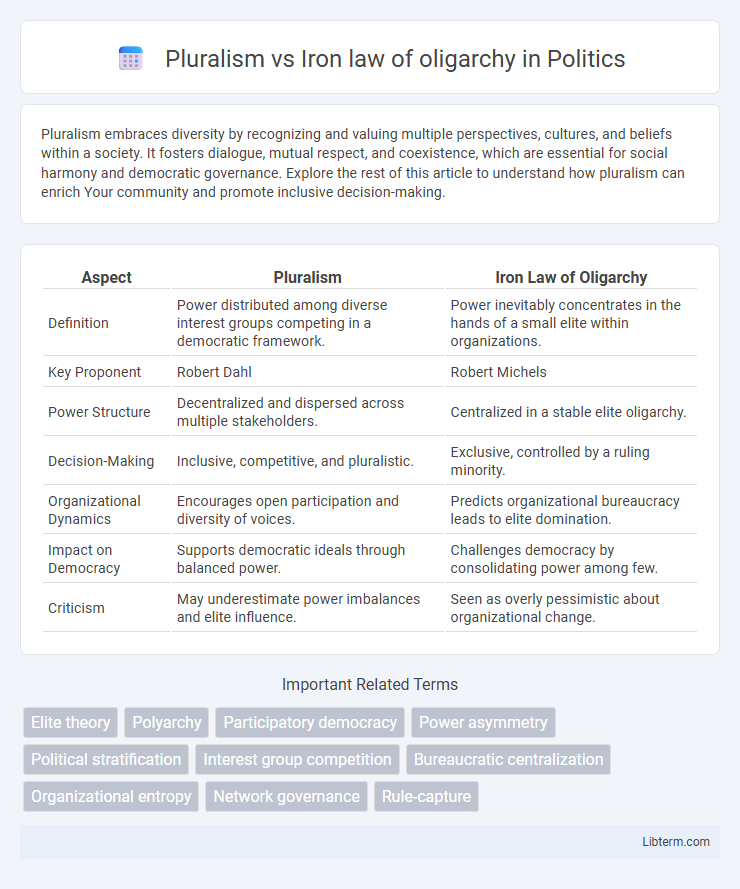Pluralism embraces diversity by recognizing and valuing multiple perspectives, cultures, and beliefs within a society. It fosters dialogue, mutual respect, and coexistence, which are essential for social harmony and democratic governance. Explore the rest of this article to understand how pluralism can enrich Your community and promote inclusive decision-making.
Table of Comparison
| Aspect | Pluralism | Iron Law of Oligarchy |
|---|---|---|
| Definition | Power distributed among diverse interest groups competing in a democratic framework. | Power inevitably concentrates in the hands of a small elite within organizations. |
| Key Proponent | Robert Dahl | Robert Michels |
| Power Structure | Decentralized and dispersed across multiple stakeholders. | Centralized in a stable elite oligarchy. |
| Decision-Making | Inclusive, competitive, and pluralistic. | Exclusive, controlled by a ruling minority. |
| Organizational Dynamics | Encourages open participation and diversity of voices. | Predicts organizational bureaucracy leads to elite domination. |
| Impact on Democracy | Supports democratic ideals through balanced power. | Challenges democracy by consolidating power among few. |
| Criticism | May underestimate power imbalances and elite influence. | Seen as overly pessimistic about organizational change. |
Understanding Pluralism: A Framework for Diverse Power
Pluralism provides a framework for understanding power as dispersed among multiple interest groups, ensuring no single entity dominates political decision-making. This model emphasizes the role of competing organizations in representing diverse societal interests, promoting inclusive participation and preventing centralized control. Contrasting with the Iron Law of Oligarchy, pluralism highlights the dynamic interaction and balance of power necessary for democratic governance.
The Iron Law of Oligarchy: Origins and Key Concepts
The Iron Law of Oligarchy, formulated by Robert Michels in the early 20th century, asserts that all complex organizations inevitably develop oligarchic structures where a small elite monopolizes power. This theory challenges the principles of pluralism by highlighting the concentration of decision-making authority, regardless of democratic intentions, due to organizational necessities such as leadership efficiency and control. Key concepts include leadership entrenchment, bureaucratic hierarchy, and the paradox of democracy succumbing to centralized elite domination.
Historical Evolution of Pluralism vs Oligarchy
The historical evolution of pluralism contrasts sharply with the iron law of oligarchy, which posits that all organizations inevitably develop oligarchic leadership structures over time. Pluralism emerged in the early 20th century as a response to concerns about concentrated power, emphasizing diverse interests and multiple centers of authority within democratic systems. Over decades, scholars like Robert Dahl expanded pluralist theory to highlight competitive group influence, while critiques of oligarchy by Robert Michels underscored the persistence of elite domination despite democratic aspirations.
Power Distribution in Modern Societies
Pluralism advocates for a decentralized distribution of power, where multiple groups influence decision-making processes to ensure democratic representation. In contrast, the Iron Law of Oligarchy posits that despite organizational efforts, power inevitably concentrates in the hands of a few elites, limiting broader participation. Modern societies often grapple with these dynamics as political power fluctuates between dispersed interest groups and entrenched ruling elites.
Elite Control: Myths and Realities
Elite control in pluralism emphasizes diverse groups sharing power, promoting competitive influence and preventing dominance. The iron law of oligarchy argues that elites inevitably consolidate control, restricting democratic participation and decision-making. Understanding these perspectives reveals myths about elite inclusivity and highlights realities of power concentration in political systems.
Pluralism in Political Systems: Strengths and Weaknesses
Pluralism in political systems promotes diverse interest groups competing for power, ensuring representation and preventing dominance by a single entity, which enhances democratic responsiveness. Strengths of pluralism include fostering inclusivity and encouraging citizen participation, while weaknesses involve potential gridlock and disproportionate influence by well-organized groups. This contrasts with the Iron Law of Oligarchy, which argues that all organizations, regardless of initial democratic intentions, tend to concentrate power in the hands of a few elites.
Oligarchic Tendencies in Democratic Institutions
Oligarchic tendencies in democratic institutions manifest when power increasingly concentrates in the hands of a few elites, undermining broad-based participation and pluralistic representation. According to the Iron Law of Oligarchy, even organizations with democratic ideals inherently evolve toward oligarchy as leaders consolidate authority to maintain control. This dynamic challenges pluralism by limiting diverse interests and weakening institutional mechanisms designed to ensure accountability and inclusivity.
Case Studies: Real-World Manifestations
Case studies highlight pluralism in the U.S. political system, where multiple interest groups compete for influence, promoting diverse participation and preventing monopoly of power. Contrastingly, the Iron Law of Oligarchy is evident in organizations like large labor unions and political parties, where leadership tends to consolidate power, limiting grassroots involvement. Empirical studies of Swedish trade unions reveal initial democratic structures that gradually evolve into oligarchic control, exemplifying Michels' theory in practice.
Resistance, Reform, and the Challenge to Oligarchy
Pluralism promotes resistance against concentrated power through diverse interest groups that foster reform by advocating for decentralization and accountability, challenging the iron law of oligarchy which asserts inevitable elite dominance in organizations. Reform efforts under pluralism emphasize increased transparency and participation to disrupt oligarchic control. Persistent resistance mobilizes collective action that weakens entrenched elites, facilitating democratic adaptability and mitigating oligarchic entrenchment.
Future Prospects: Balancing Pluralism and Oligarchic Threats
Future prospects for political systems hinge on effectively balancing pluralism's inclusive participation with the iron law of oligarchy's tendency toward concentrated power. Emerging technologies and increased civic engagement present opportunities to enhance transparency and accountability, mitigating oligarchic dominance. Sustained efforts to empower diverse interest groups and institutional reforms can foster resilient governance structures that accommodate pluralism while curbing oligarchic consolidation.
Pluralism Infographic

 libterm.com
libterm.com